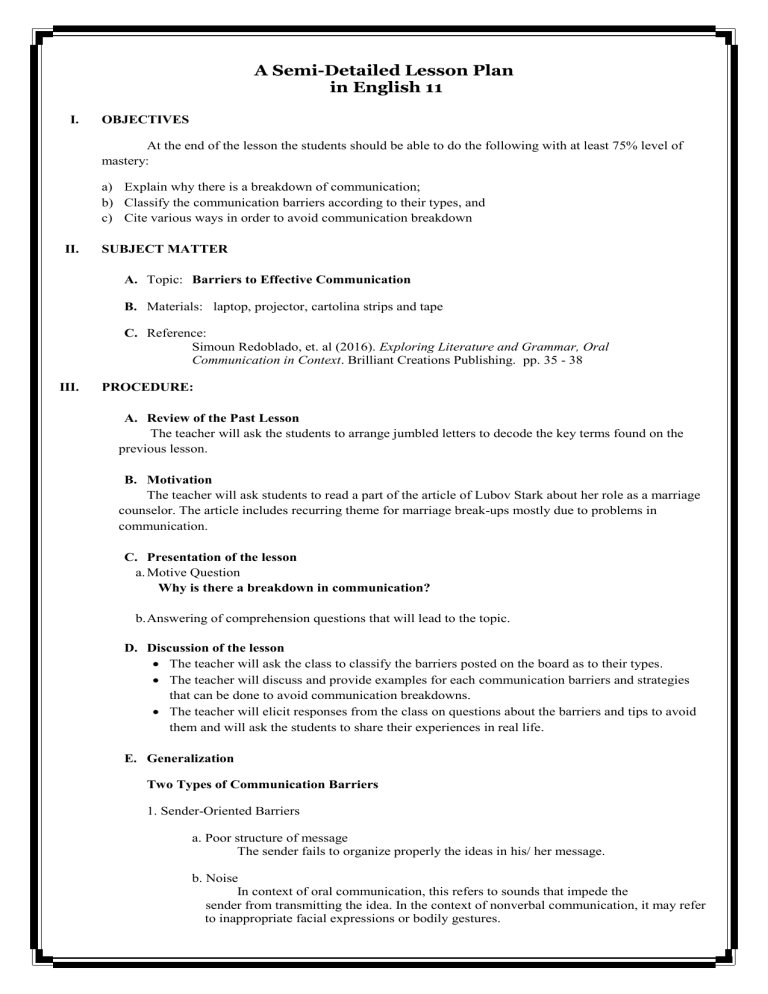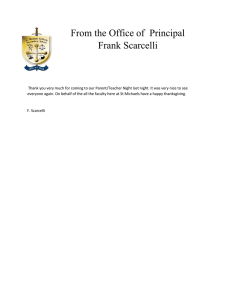
A Semi-Detailed Lesson Plan in English 11 I. OBJECTIVES At the end of the lesson the students should be able to do the following with at least 75% level of mastery: a) Explain why there is a breakdown of communication; b) Classify the communication barriers according to their types, and c) Cite various ways in order to avoid communication breakdown II. SUBJECT MATTER A. Topic: Barriers to Effective Communication B. Materials: laptop, projector, cartolina strips and tape C. Reference: Simoun Redoblado, et. al (2016). Exploring Literature and Grammar, Oral Communication in Context. Brilliant Creations Publishing. pp. 35 - 38 III. PROCEDURE: A. Review of the Past Lesson The teacher will ask the students to arrange jumbled letters to decode the key terms found on the previous lesson. B. Motivation The teacher will ask students to read a part of the article of Lubov Stark about her role as a marriage counselor. The article includes recurring theme for marriage break-ups mostly due to problems in communication. C. Presentation of the lesson a. Motive Question Why is there a breakdown in communication? b. Answering of comprehension questions that will lead to the topic. D. Discussion of the lesson The teacher will ask the class to classify the barriers posted on the board as to their types. The teacher will discuss and provide examples for each communication barriers and strategies that can be done to avoid communication breakdowns. The teacher will elicit responses from the class on questions about the barriers and tips to avoid them and will ask the students to share their experiences in real life. E. Generalization Two Types of Communication Barriers 1. Sender-Oriented Barriers a. Poor structure of message The sender fails to organize properly the ideas in his/ her message. b. Noise In context of oral communication, this refers to sounds that impede the sender from transmitting the idea. In the context of nonverbal communication, it may refer to inappropriate facial expressions or bodily gestures. c. Faulty choice of words The sender uses terms that are suggestive or ambiguous in meaning or uses terms that understate or exaggerate the idea. d. Inappropriate quantity of information The sender reveals too little or too much information. 2. Receiver-Oriented Barriers a. Poor retention of ideas The receiver fails to remember points from the sender’s message. b. Inattentive listening The receiver pays little or no attention to the sender’s message. c. Tendency to evaluate The receiver judges the validity of the sender’s message even before the sender finishes communicating. Ways on How to Avoid Communication Barriers 1. Use appropriate language. 2. Avoid using filler words like “um,” “maybe,” or “a little bit.” Make your message concise. 3. Send consistent signals. 4. Reduce physical distractions. Stay away from background noise, interruptions and uncomfortable settings. IV. EVALUATION In the given situation below, identify two barriers that hindered communication to take place effectively and cite three ways on how it could have been avoided. Frank called Rose on the phone to ask her out on a date. May: Frank: May: Frank: May: Frank: May: Hello. Um, hi Rose! It’s me Frank. Oh! Hi Frank. I called to um… can you... would you like to go out with me tomorrow? I can hardly hear you Frank. Where are you? I’m sorry, I’m in a bus. So, what’s your answer? Hello? I can’t hear you. From the bus station, Frank went straight ahead to May’s house. May: What was that you were trying to say Frank? Frank: I was hoping we can maybe go out tomorrow, if you’re free of course and if your parents would allow me to take you out and if you don’t have any plans on going out with your friends or hanging out with your siblings o maybe if you are not asked to run some errands or go to school tomorrow. (while May was using her phone) May: I’m a bit lost here. What was that again? Frank: Oh. I would like to ask you out tomorrow. Are you free by then? May: Maybe. V. ASSIGNMENT Give three other barriers that emanate from other elements of communication. Explain your answers and suggest ways to overcome them. Prepared by: JUSTIN A. SANCHEZ

